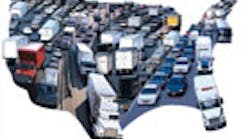The American Public Works Association (APWA), a part of the National Transportation Operations Coalition (NTOC), has given America’s traffic signals a D grade in their 2007 Traffic Signal Report Card, but that’s up from a D- in the 2005 assessment.
The report suggests that cities, counties, and states can make huge gains in mitigating congestion through minor changes in the way they manage and operate traffic signal systems.
“We have an aging infrastructure, because so much of it was built in the mid-20th century, and the funding stream for construction and maintenance just isn’t there,” Marshall Elizer, spokesperson for the National Transportation Operations Coalition (NTOC), told FleetOwner.However, Elizer said there has been a level of improvement, with numerous agencies receiving an improved score since the previous assessment. The problem is that there are limited resources to operate public infrastructure, and each agency currently doesn’t have enough resources to be run at a more efficient level.
The APWA report says that the major reason there haven’t been many advances on the national level is “the timing and nature of most agency funding cycles are not long enough for most jurisdictions to have fully implemented significant changes from a budgetary perspective.”
APWA suggests that as little as $3 per U.S. household per year ($218 million total) invested in signal improvements could produce benefits of $45 billion a year as well as shorter commute times, improved air quality, and better fuel efficiency.
"This is not about traffic signals turning green, yellow and red," said APWA president Larry Frevert. "Just because signals continue to change color does not mean they operate efficiently. Increased demands and limited resources are complicating the ability of public agencies to manage efficient systems and reduce congestion. Allocating funds to improve these services will produce far-reaching, immediate results."
The full report is available at the National Transportation Operations Coalition website .



